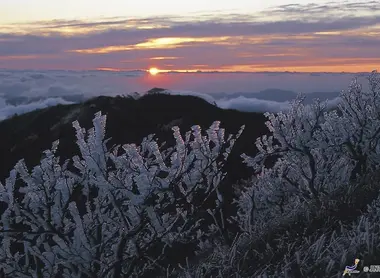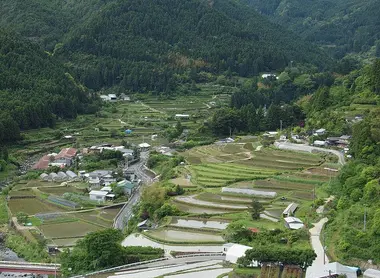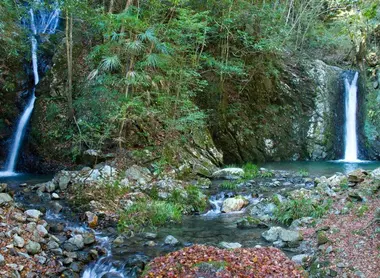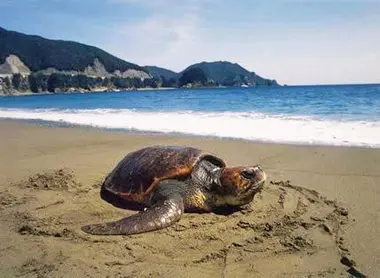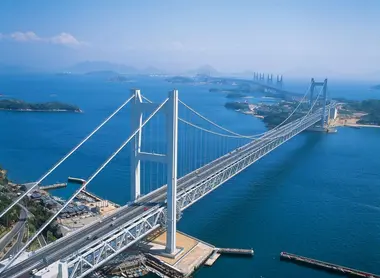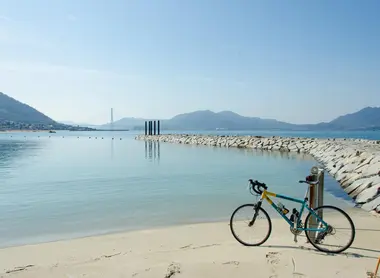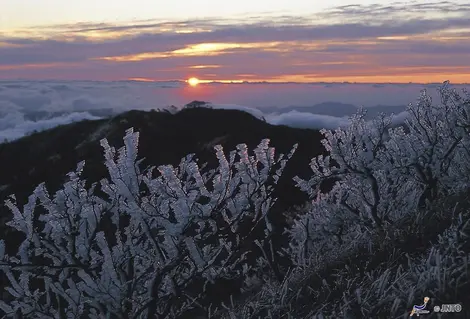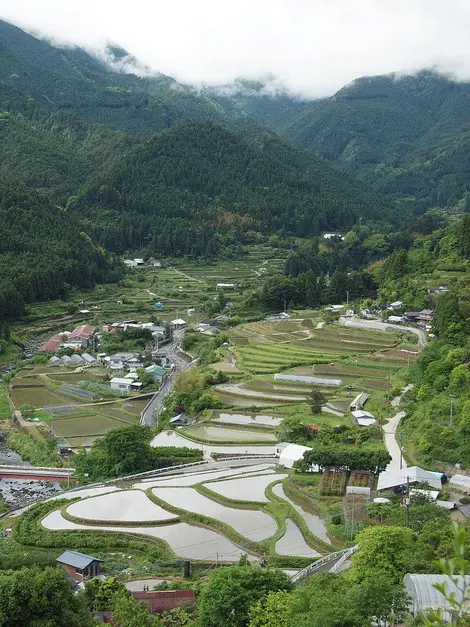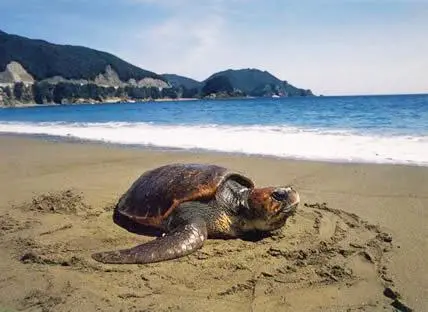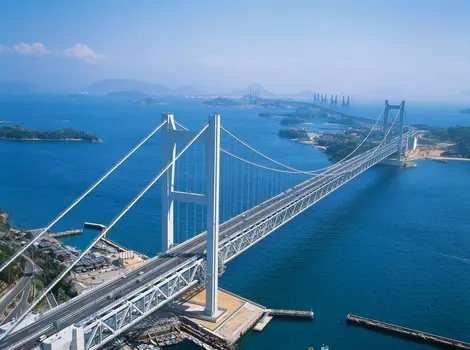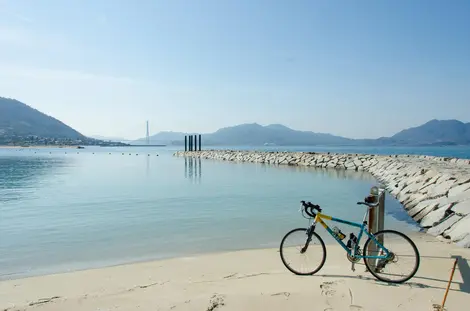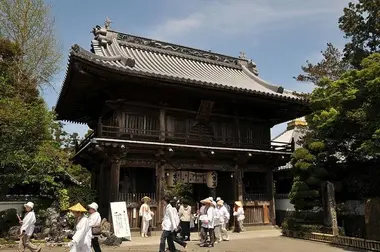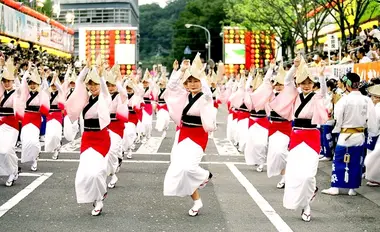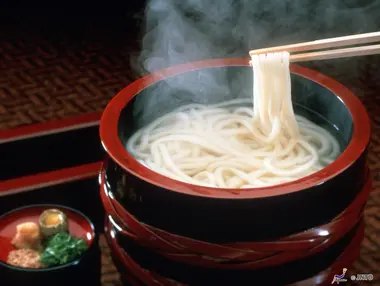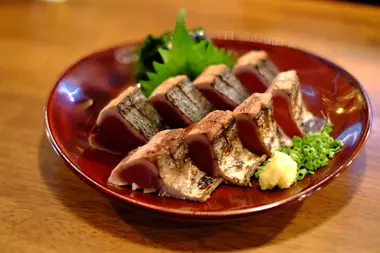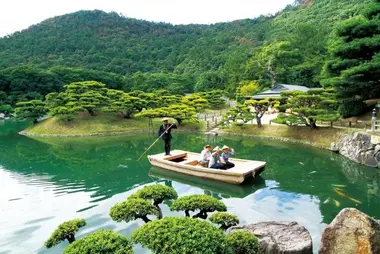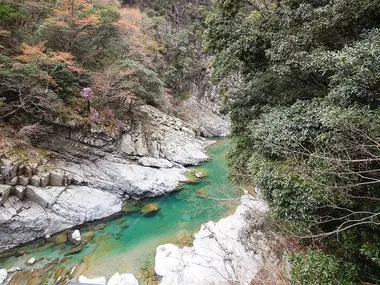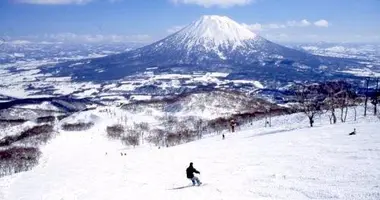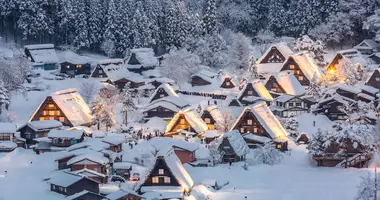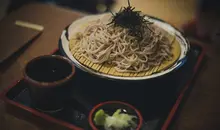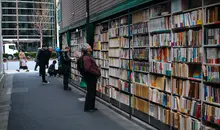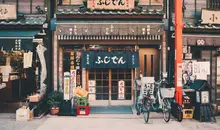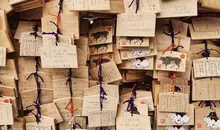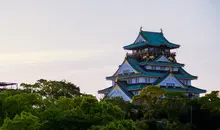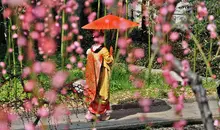Shikoku Island
- Published on : 01/09/2020
- by : I.D.O.
- Youtube
Shikoku, the smallest of Japan's four main islands
Nestled in the south of the Japanese archipelago, Shikoku is the smallest of Japan's four large islands. Its name literally means "four countries", in reference to the four historic provinces that once made it up, and which have now become prefectures. With its 18,800 km² and approximately 4.5 million inhabitants, this island offers an exceptional wealth of traditions, natural landscapes and authentic cultural experiences. Often overlooked by conventional tourist circuits, Shikoku reveals a rural and unspoilt Japan, far removed from the hustle and bustle of the big cities.
Geography and characteristics of Shikoku
Shikoku is located in the southwest of the large island of Honshu, from which it is separated by the Seto Inland Sea. Its southern coasts are bordered by the Pacific Ocean, offering contrasting landscapes between the north and south of the island. Mountain ranges form natural boundaries between regions, notably between north and south. The island's highest peak is Mount Ishizuchi, 1,982 metres above sea level in Ehime prefecture.
The north, closer to the major cities of Kansai, is more industrialized and developed than the south, which is essentially agricultural. Thanks to its milder climate, the South is renowned for its production of various types of citrus fruit, notably mandarins, yuzu and sudachi. These fruits are grown on terraced land that enjoys maximum sunshine.
Unlike Japan's other three large islands, Shikoku has no volcanoes and a topography characterized by mountains, deep valleys and steep coastlines. This particular geography has long contributed to the island's relative isolation, preserving its traditions and authentic way of life.
Shikoku's four prefectures and their attractions
Kagawa Prefecture (Northwest)
Formerly known as Sanuki Province, Kagawa is Japan's smallest prefecture. Its capital, Takamatsu, is home to some 419,000 inhabitants, almost half the prefecture's population. The city is famous for its Ritsurin Garden, considered one of the most beautiful gardens in Japan. This historic garden, created during the Edo period, features carefully composed landscapes with ponds, bridges and tea pavilions.
Kagawa Prefecture is famous for its Sanuki udon, large udon (wheat noodles) served in a broth of seaweed and soy sauce. This culinary specialty attracts many visitors to local restaurants.
Don't miss the Goshikidai Plateau in the Sanuki Goshikidai National Park for a sublime view of the Seto Inland Sea, as well as Marugame with its keep, one of the last 12 original castles in Japan. The town is also famous for its handcrafted round fans, the Marugame Uchiwa.
Kagawa is also home to the Kotohira-gu shrine, better known as Konpira-san, a popular pilgrimage site reached after climbing 1,368 steps.
Ehime Prefecture (Southeast)
Corresponding to the former province of Iyo, Ehime prefecture's capital is Matsuyama, Shikoku's most populous city with around 516,000 inhabitants. The town is famous for its feudal castle, Matsuyama-jô, one of Japan's 12 original castle keeps. Built in 1602, it offers panoramic views of the city and the inland sea.
Another must-see is the Dôgo Onsen, one of Japan's oldest and most famous spas, with a history dating back over 1,000 years. This hot spring is said to have inspired Hayao Miyazaki's animated film "Chihiro's Journey".
Ehime prefecture is also known for its jakoten, a Uwajima specialty consisting of a kind of fish pate cut into rectangles and then fried, eaten more like a snack.
Nature lovers can explore the Shikoku karst plateau on the border with Kochi prefecture, or Mount Ishizuchi, the island's highest peak. The region is also renowned for its production of lacquerware and blue and white porcelain.
For cyclists, the Shimanami Kaido trail linking Honshu (Onomichi) to Shikoku (Imabari) is a unique experience, crossing six rural islands over 70 kilometers with spectacular views.
Kochi Prefecture (Southwest)
Formerly known as the province of Tosa, Kochi occupies all of southern Shikoku. Its eponymous capital has a population of around 340,000. Visit the town of Kochi on one of our tours!
The town is famous for its castle, built in the early 17th century, one of only 12 ancient castles in Japan to have preserved its original structure. Its Sunday market (Kôchi ichiba), in existence for over 300 years, offers local vegetables and freshly caught fish.
Japan's leading producer of yuzu, Kochi is famous for its katsuo tataki, a sashimi of bonito with only the skin grilled. This dish is usually accompanied by garlic and onion straw, and served with ponzu sauce (citrus soy sauce).
Kochi is also the birthplace of Sakamoto Ryoma, one of Japan's 19th-century reformers, whose memory is omnipresent in the city.
The Shimanto River, considered Japan's last clear river (and the only one without a dam), is ideal for rafting, canoeing, camping and hiking. Cape Ashizuri to the south-west and Cape Muroto to the south-east offer spectacular hikes along the Pacific coast.
Local handicrafts include washi paper and knife blades. The Shikoku dog breed, also known as the "Kōchi dog", originated in this prefecture.
Tokushima prefecture (Northeast)
Tokushima: with around 264,000 inhabitants, the capital is the starting point of the Shikoku pilgrimage, with the Ryozen-ji temple (no. 1). The city is most famous for its Awa-Odori festival, which takes place every year in mid-August and attracts over a million visitors. Outside this period, the Awa Odori Kaikan museum offers daily performances of this traditional dance.
The town of Naruto takes its name from the famous whirlpools that can be seen from the Onaruto-kyo bridge linking Shikoku to the island of Awaji. These whirlpools, which can reach 20 metres in diameter, are created by the difference in water level between the Seto Inland Sea and the Pacific Ocean.
The tourist sites for which Tokushima is famous are mainly to be found in the mountains, such as Iya Valley, with its steep mountains, lush forests, gorges, rivers, waterfalls and vine-creeper suspension bridges (kazura-bashi).
Tokushima's cuisine is distinguished by chikuwa, a tube of cooked fish paste, and sudachi, a small, highly acidic citrus fruit harvested green for its sour juice, which is used to flavor many dishes. Local crafts are characterized by indigo dyeing (Awa ai) and pottery.
The famous 88-temple pilgrimage
Shikoku has been primarily known for centuries for its 88-temple pilgrimage, known as the "Shikoku Hachijūhakkasho" (四国八十八ヶ所), dedicated to the revered monk Kūkai, also known as Kōbō Daishi (774-835), a native of the island. This spiritual route stretches for 1,170 kilometers and attracts thousands of pilgrims every year, known as "henro". The pilgrimage generally begins at Ryōzen-ji temple in Tokushima prefecture and ends at Ōkubo-ji temple in Kagawa prefecture. Traditionally, pilgrims are dressed in a white robe, a symbol of purity and innocence, wear a conical hat to protect themselves from the sun and rain, and use a walking stick that symbolically represents Kōbō Daishi himself, who accompanies them on their journey.
Although traditionally carried out on foot, the pilgrimage can now be made by car, bus or train. It is not necessary to visit all 88 temples in a row, and some pilgrims do it in stages over several years. The complete circuit on foot generally takes between 40 and 60 days.
At each temple, pilgrims receive a stamp and calligraphy in their pilgrimage book (nōkyōchō), testifying to their visit. In many temples, they also recite the Hannya Shingyō (Heart Sūtra) and other prayers, and offer incense, candles and fuda (small wooden boards bearing their names).
A particular feature of the Shikoku pilgrimage is the osettai, a tradition of hospitality in which locals spontaneously offer pilgrims small gifts, food or even accommodation, as a sign of respect and to gain spiritual merit.
Getting to and around Shikoku
Access to Shikoku has improved considerably over the years, with various options available to travelers.
By air
Each of Shikoku's four prefectures has its own airport: Takamatsu (Kagawa), Matsuyama (Ehime), Kochi and Tokushima. These airports are connected several times a day to Tokyo and other major Japanese cities. Takamatsu airport even offers international flights to Seoul, while Matsuyama airport has connections to Seoul and Shanghai.
By train
JR trains link the island to Honshu via Okayama and Shin-Osaka. Although Shikoku is the only one of the four large islands not to benefit from Shinkansen (high-speed rail), local rail lines provide an efficient means of getting around the island. The JR Shikoku network circles the island and serves most of the main tourist sites.
For visitors wishing to explore Shikoku by train, the All Shikoku Rail Pass offers unlimited access to the island's JR trains for 3, 4 or 5 days.
By road
Three major bridges link Shikoku to Honshu:
- Seto Ohashi Bridge (north), linking Sakaide (Kagawa) to Kurashiki (Okayama)
- Kobe-Awaji-Naruto bridge (east), linking Naruto (Tokushima) to Kobe via Awaji island
- Nishiseto or Shimanami Kaido bridges (north-west), linking Imabari (Ehime) to Onomichi (Hiroshima)
To discover Shikoku, rent a car and hit the road! Renting a car is often the most practical way to explore Shikoku's more remote regions, where public transport may be limited. The road network is well-developed, and driving is generally easy, although some mountain roads can be narrow and winding.
By ferry
Several ferry services link Shikoku to the mainland:
- Ferries from Hiroshima to Matsuyama
- Ferries from Osaka and Kobe to Takamatsu
- Ferries from Wakayama to Tokushima
These crossings often offer spectacular views of the Seto Inland Sea and its many islands.
Traditions, festivals and cultural specialities
Festivals (Matsuri)
Shikoku is home to several of the region's best festivals, attracting visitors from all over Japan and even abroad:
Tokushima'sAwa-Odori is one of Japan's most famous dance festivals. It takes place every year from August 12 to 15 and attracts over a million spectators. Groups of dancers (ren) roam the streets, performing synchronized movements to the sound of drums, flutes and shamisen. The festival is known for its joyful atmosphere and its motto: "Fools dance and fools watch, so might as well dance".
Kochi's Yosakoi Festival, held every year in mid-August, is a dynamic celebration where around 20,000 dancers from all over Japan perform colorful, energetic choreography on the city's streets.
The Niihama Taiko Matsuri (Niihama Drum Festival) in Ehime prefecture is also known as the "men's festival" because of the strength required to carry and handle the huge, decorated drum floats (taikodai).
Unique traditions
In addition to the pilgrimage to the 88 temples, Shikoku has several unique cultural traditions:
Bullfighting (Ushi-zumo) in Uwajima, Ehime prefecture, is a centuries-old tradition unique to Japan. Unlike Spanish bullfighting, this is a competition between two bulls who fight until one of them gives up. These fights attract a large amateur audience and represent a fascinating aspect of local culture.
Indigo dyeing (Awa Ai) in Tokushima prefecture is a craft tradition dating back to the Edo period. The region once produced almost 90% of Japan's indigo, profoundly influencing the prefecture's cultural identity and history.
The Awa Ningyo Jururi puppet theater in Tokushima is a traditional form of puppet theater that requires three puppeteers to manipulate each doll.
Gastronomy and local crafts
Culinary specialties
Shikoku cuisine is renowned throughout the archipelago. It abounds in fish and citrus fruits of all kinds, and rice cultivation is highly developed. Each prefecture has its own specialties:
Kagawa Sanuki udon are thick udon served in a broth of seaweed and soy sauce. So popular is this specialty that Kagawa Prefecture is sometimes nicknamed "Udon Prefecture" and boasts over 700 specialized restaurants.
Kochi 's katsuo no tataki is a preparation of bonito, lightly grilled on the outside and raw on the inside, served with a citrus ponzu sauce.
Ehime's jakoten is an Uwajima specialty, consisting of a fish pâté cut into rectangles and deep-fried.
Tokushima sudachi are small, highly acidic green citrus fruits that flavor many dishes and beverages.
Ehime's tai meshi (sea bream rice) is prepared with minced sea bream mixed with rice and cooked in an earthen pot.
Traditional crafts
Shikoku is also rich in traditional crafts:
Kagawa lacquerware (Kagawa Shikki) is a traditional craft developed under the protection of the lords of the Takamatsu estate during the Edo period. Craftsmen use techniques such as Kinma, Zonsei and Choshitsu to create pieces of remarkable beauty.
Round fans from Marugame (Marugame Uchiwa) in Kagawa prefecture account for 90% of national paper fan production.
Washi paper from Awa in Tokushima prefecture is handmade using traditional methods dating back over 1,200 years.
Takamatsu bonsai is renowned throughout Japan. The Kinashi and Kokubunji region accounts for around 80% of national pine bonsai production.
Aji stone (Aji-ishi), a type of granite from the Takamatsu region, is used to create lanterns, sculptures and other decorative objects.
Must-see activities and natural sites
Shikoku offers a wide variety of natural landscapes and outdoor activities:
Remarkable natural landscapes
The Iya Valley in Tokushima Prefecture is famous for its deep gorges, steep mountains and vine-covered suspension bridges (kazura-bashi). This remote region, once home to the Taira clan in the 12th century, retains its traditional way of life and spectacular scenery.
Cape Ashizuri in Kochi prefecture offers breathtaking cliffs overlooking the Pacific Ocean and is home to the Shikoku Seiyo Geopark, a site renowned for its unique geology and biodiversity.
The Naruto whirlpools in Tokushima prefecture are one of Japan's most impressive natural phenomena, created by the difference in water level between the Seto Inland Sea and the Pacific Ocean.
The Shimanto River in Kochi Prefecture, nicknamed "Japan's last clear river", is a paradise for water sports and fishing enthusiasts.
Outdoor activities
The Shimanami Kaido cycle path linking Honshu (Onomichi) to Shikoku (Imabari) via six small islands is one of the world's most scenic cycle routes, offering breathtaking views of the Seto Inland Sea.
There are many hot springs (onsen) in Shikoku, the most famous being the Dogo Onsen in Matsuyama, one of the oldest in Japan with a history dating back over 1,000 years.
Hiking Mount Ishizuchi, the highest mountain in western Japan, offers panoramic views and a spiritual experience, as the mountain is considered sacred.
Rafting and kayaking on Kochi's rivers, notably the Yoshino and Shimanto, attract thrill-seekers.
Artistic islands of the Inland Sea
Close to Shikoku, in the Seto Inland Sea, are several islands that have become famous for their contemporary art installations, together forming The Setouchi Region:
Naoshima Island has become an international art destination, home to several museums designed by architect Tadao Ando, including the Chichu Art Museum and the Benesse House Museum. There are also Naoshima's outdoor artworks, such as Yayoi Kusama's famous yellow pumpkin.
Teshima Island is home to the Teshima Art Museum, with its teardrop-shaped structure housing a single huge art installation.
The largerisland of Shôdoshima is known for its olive groves, soybean industry and landscapes reminiscent of the Mediterranean.
Other islands such as Inujima Island, Honjima Island, Ibukijima Island, Awashima Island, Shamijima Island, Takamijima Island, Ogijima Island and Megijima Island are also home to art installations, especially during the Setouchi Triennale, an international contemporary art festival held every three years.
To discover Shikoku's cultural treasures, check out our "Art & Architecture in the Inland Sea" tour
Shikoku is truly a destination apart in Japan, offering a unique blend of centuries-old traditions, unspoilt natural landscapes and authentic experiences. Whether you're drawn to spiritual pilgrimage, outdoor adventures, local gastronomy or contemporary art, this island largely untouched by mass tourism offers unforgettable discoveries and a glimpse of traditional Japan that has survived the country's rapid modernization.
Further afield
- Uchiko, a village in Shikoku
- Setouchi region
- Naoshima Island
- Teshima Island
- Shôdoshima Island
- Inujima Island
- Honjima Island
- Ibukijima Island
- Awashima Island
- Shamijima Island
- Takamijima Island
- Ogijima Island
- Megijima Island
- Uno harbor
- Kosan-ji temple
- Myths of the Seto Inland Islands
- Pirates and fighters of the Seto Inland Sea
- The yôkai of the Seto Inland Sea
- Open-air works of art in Naoshima
Address, timetable & access
Address
Access
By plane: the 4 major cities in the 4 prefectures are served several times a day from Tokyo.
By train: JR trains link the island to Honshu via Okayama and Shin-Osaka.
By bus: two buses connect Kansai International Airport with Takamatsu and Tokushima.
By car: bridges provide access to Shikoku via Naruto (east), Seto (north) or Shimanami / Imabari (north-west).
By boat: ferries from Hiroshima to Matsuyama, from Osaka and Kobe to Takamatsu and from Wakayama to Tokushima.
